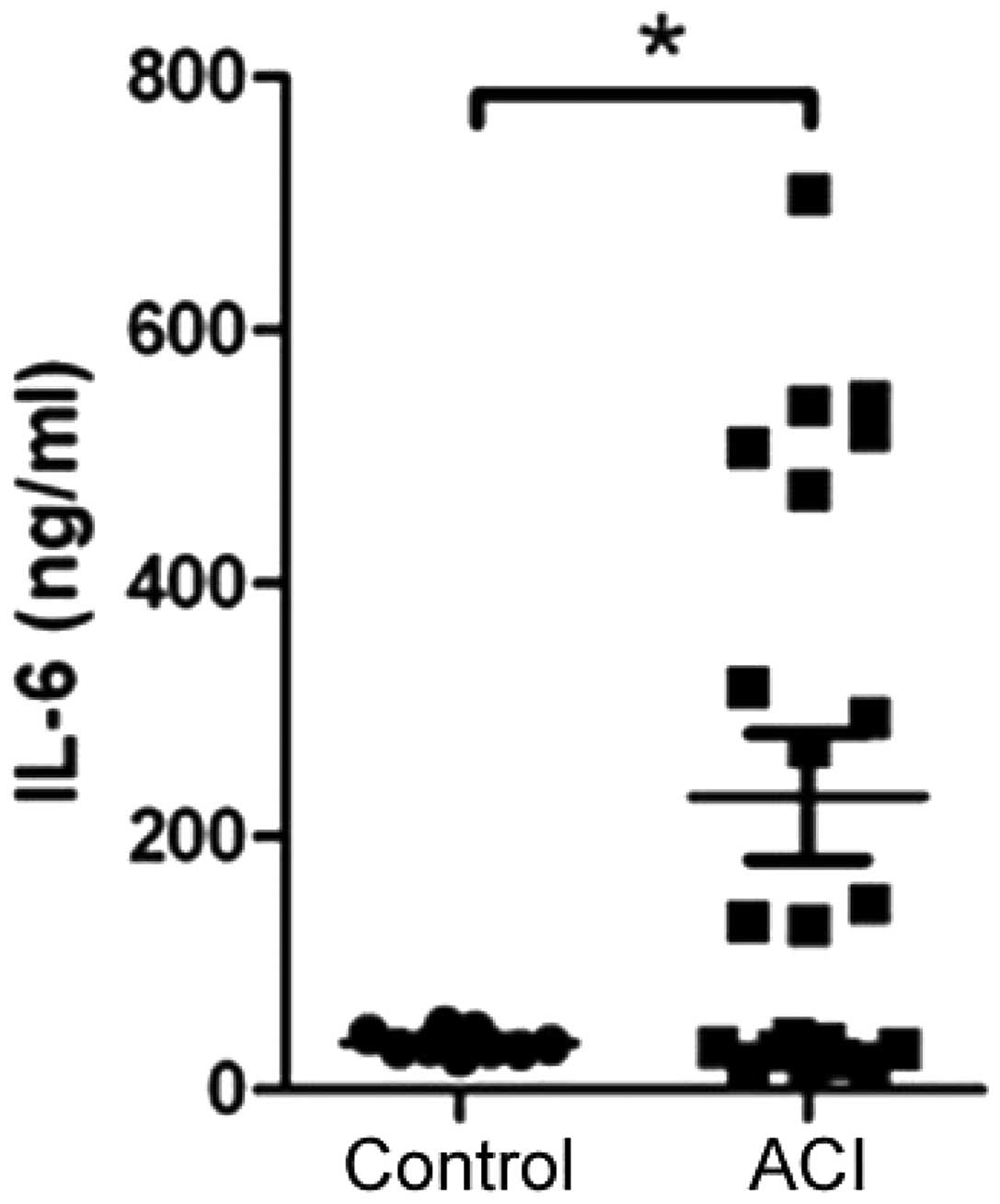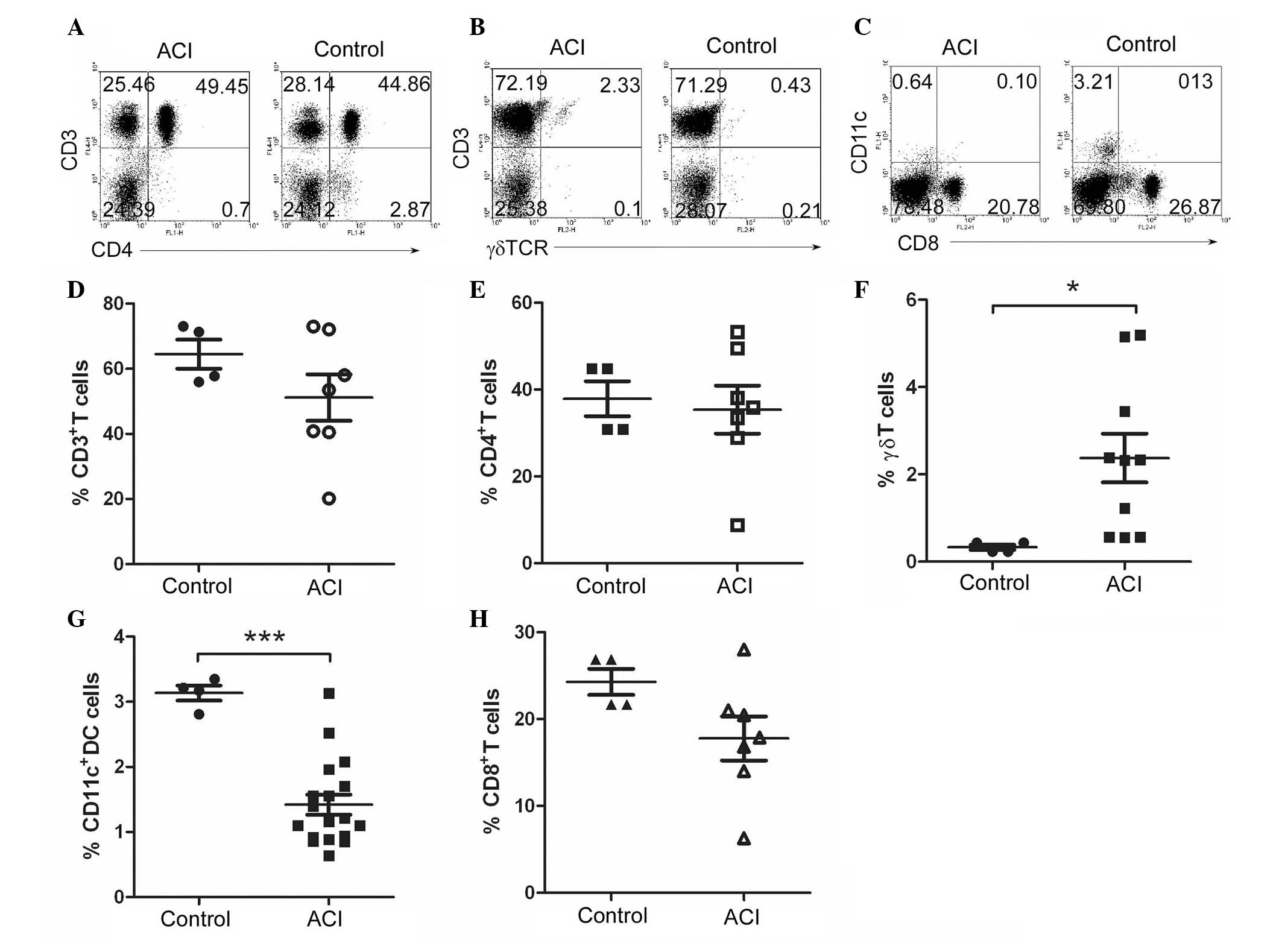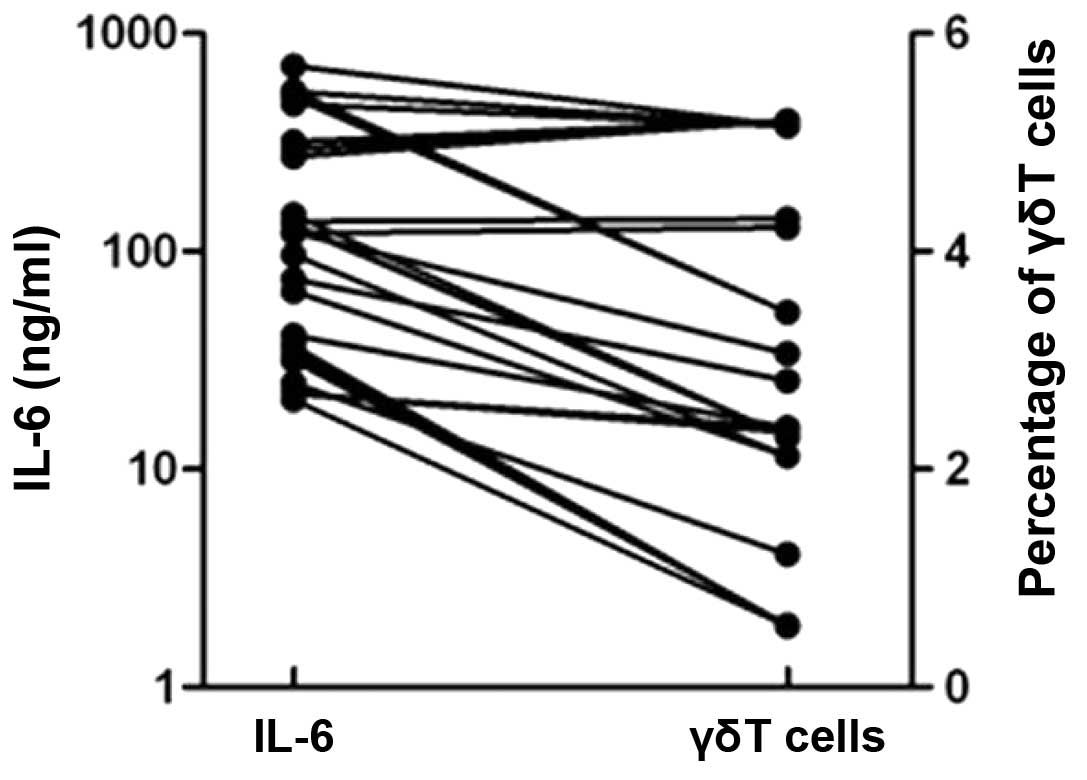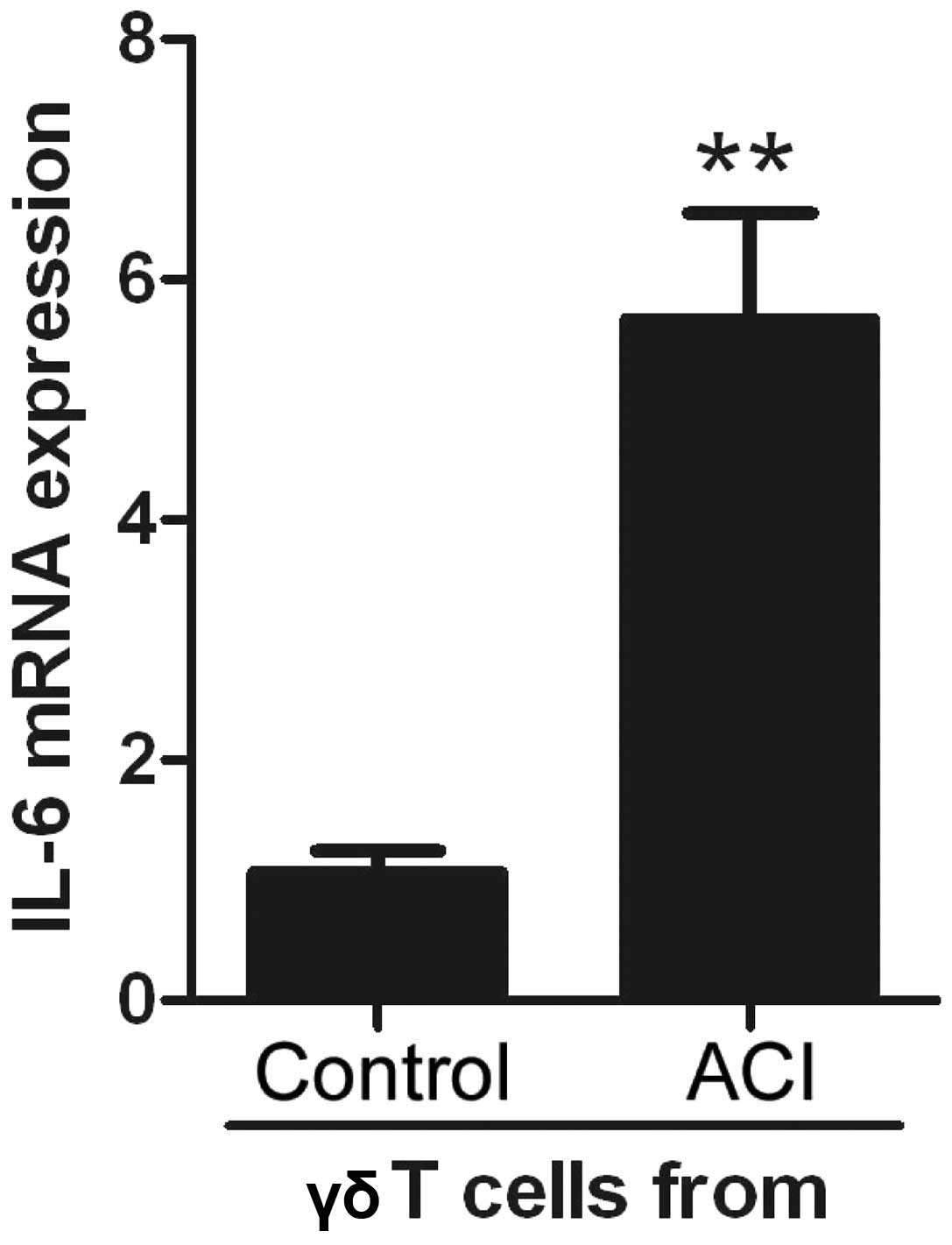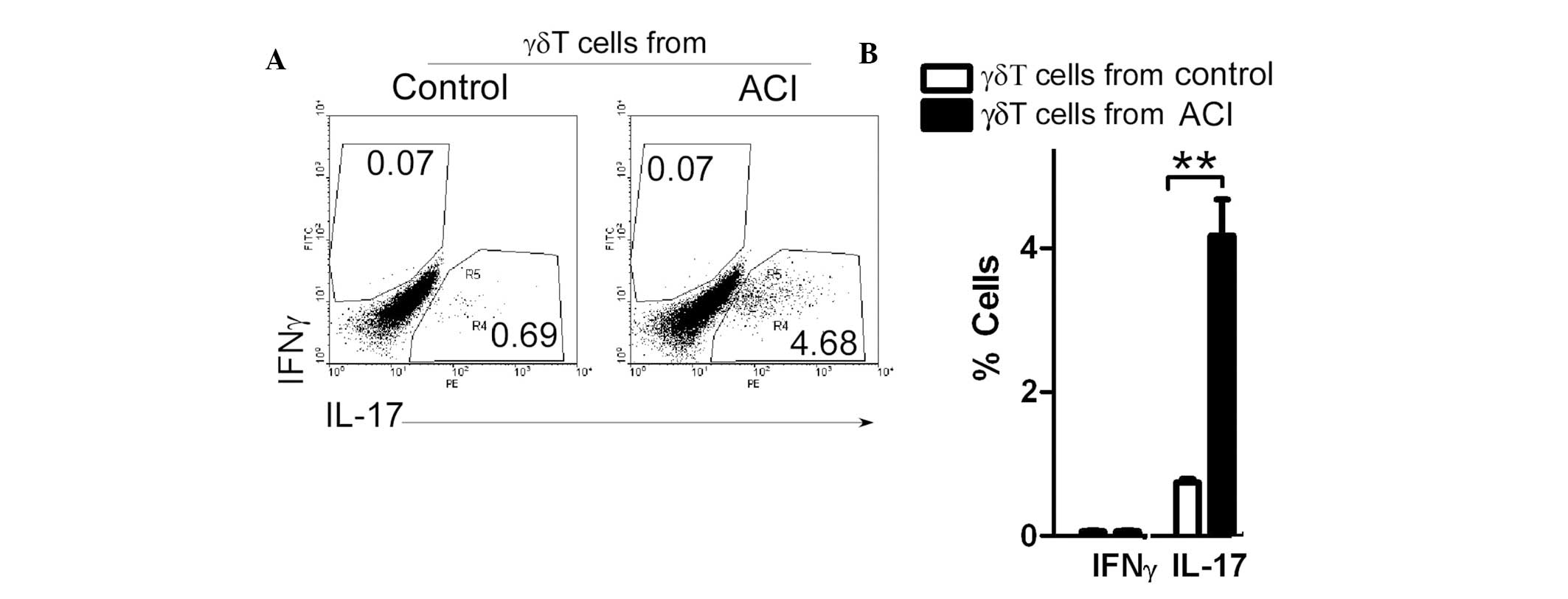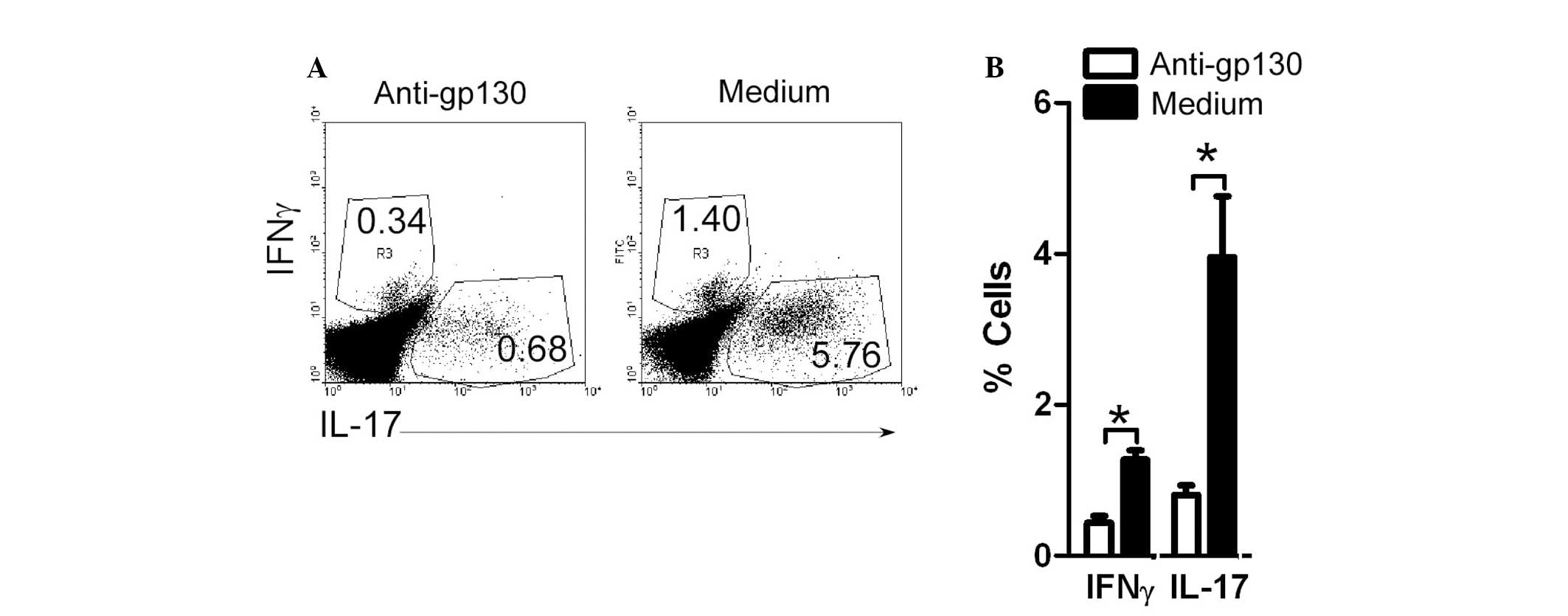Novel IL-6-secreting γδT cells increased in patients with atherosclerotic cerebral infarction
- Authors:
- Published online on: October 29, 2014 https://doi.org/10.3892/mmr.2014.2796
- Pages: 1497-1503
Abstract
Introduction
Stroke is a leading cause of death in the United States. Approximately 85% of strokes are ischemic and 15% are hemorrhagic. Cardioembolic stroke, microvascular disease and atherothrombosis are the three major etiologies of ischemic stroke (1). There are known to be two principal causes of atherosclerotic cerebral infarction (ACI): Atherosclerosis (AS) and plaque rupture (2). AS is a chronic inflammatory disease that involves various immune cells, particularly T lymphocytes, such as CD4+ T-helper cells (3,4). The increased production of T-helper (Th)17 cells, has previously been shown to be critical in the pathogenesis of AS and acute coronary syndrome (5,6). Immune responses occur following acute ischemic stroke (7). A previous study recently demonstrated that Th17 cells may be increased in patients with ACI (8).
Pathological and intervention studies have implicated microorganisms in the initiation or maintenance of such inflammation (9,10); however, there is also evidence that elevated concentrations of the acute phase reactant, C-reactive protein (CRP), may predict the development of clinical coronary heart disease over many years (11). These findings suggest that inflammation may contribute to the earlier stages of ACI. Furthermore, data from the Physicians’ Health Study suggested that the beneficial effects of aspirin in reducing cardiovascular risk, are directly proportional to the degree of elevation of CRP (12), implicating a prostanoid-associated mechanism linking inflammation and atherothrombosis.
The hepatic synthesis of CRP is largely under the regulation of the proinflammatory cytokine interleukin (IL)-6 (13,14). This cytokine is unusual, in that its major effects occur at sites distinct from its origin and are consequent upon its circulating concentrations (15). A previous report from the Rural Health Study demonstrated that elevated concentrations of IL-6 predict total and cardiovascular mortality over a 5-year follow-up, with the association being independent of prevalent vascular disease, smoking and traditional risk factors; and stronger than, but additive to, that for CRP. A study using animal models strongly suggested that IL-6 may have a role in neuropathology (16). The present study showed that IL-6 levels were increased in patients with ACI. Furthermore novel IL-6-expressing γδT cells (γδT6 cells) were identified in patients with ACI. These γδT6 cells were shown to induce Th17-cell production in an IL-6 dependent manner. The results of the present study suggest that the novel γδT6 cells may be a target for strategic therapies of ACI.
Materials and methods
Patient population
The present study conformed to protocols approved by the Beijing Institute of Basic Medical Sciences Review Board (Beijing, China). The study was cross-sectional and blinded. The patients (50 male and 47 female) were examined at the Beijing Chaoyang Hospital and 307 Hospital (Beijing, China), where they were undergoing diagnostic catheterization, between May 2012 and July 2013. Ethical approval was obtained from the ethics committee of Beijing Institute of Basic Medical Sciences (Beijing, China) and informed consent was obtained from the patients, prior to commencement of the present study The patients were classified into two groups: Group 1, patients with ACI (22 males and 15 females; mean age, 56.6±9.9 years); group 2, control subjects (28 males and 32 females; mean age, 54.3±11.1 years), selected on the basis of recent angiography showing normal carotid arteries. The diagnotic criteria for ACI was modified from the Trial of Org 10172 in Acute Stroke Treatment (TOAST) criteria, based on the available clinical, radiographic and diagnostic information (17). There were no significant differences between the age ranges of the two groups.
None of the patients included in the present study were being treated with anti-inflammatory drugs and/or immunosuppressive agents. Furthermore, none of the patients suffered from subarachnoid hemorrhage, extradural or subdural hemorrhage, brain abscess, surgery or trauma, thromboembolism, disseminated intravascular coagulation, advanced liver disease, renal failure, malignant disease, other inflammatory disease, or chronic-immune-mediated disorders.
Blood samples
A total of 10 ml peripheral blood (PB) was collected from each patient, in a fasting state, on the morning following admission. The time interval between the onset of symptoms and blood sampling was <24 h in all cases. All of the samples were treated with sodium heparin and examined within 4 h. PB mononuclear cells (PBMCs) were prepared by Ficoll density gradient for flow cytometric analysis and quantitative polymerase chain reaction (qPCR). Serum was obtained from the samples, following centrifugation (900 × g at 4°C for 30 min) and stored at −80°C until further use.
qPCR analysis
Peripheral blood mononuclear cells qwew extracted for total RNA with TRIzol solution (Invitrogen Life Technologies). The final RNA pellets were dissolved in 0.1 mM EDTA (2 μl/mg original wet weight). Reverse transcription reactions were carried out on 22 μl of sample using superscript II RNAse H-Reverse Transcriptase (Invitrogen Life Technologies) in a reaction volume of 40 μl. All samples were diluted in 160 μl nuclear-free water. qPCR was employed to quantify human IL-6 gene expression from the cDNA samples. Human IL-6 was designed using Primer Express version 1.0 software (Applied Biosystems) from the human IL-6 gene sequences (GenBank/EBML databases; accession no. M54894; http://www.ncbi.nlm.nih.gov/nuccore/M54894). An 81 base-length IL-6 fragment was amplified using the primers: forward 5′-GGTACATCCTCGAC-GGCATCT-3′ and reverse 5′-GTGCCTCTTTGCTGC-TTTCAC-3′. TaqManfluorescent probe, 5′-FAM (6-carboxyfluorescein)-TGTTACTCTTGTTACATGTCTCCTTTCTCAGGGCT-3′ TAMRA (6-carboxy-tetramethylrhodamine) (Applied Biosystems) was included with the primers in each reaction.
Measurement of blood biochemistry
Blood sugar and lipid levels were determined using an enzymatic method. High sensitive C-reactive protein was measured using an immunoturbidimetric method. All of the assays were conducted using an Olympus AU2700 biochemical autoanalyzer (Olympus Coporation, Tokyo, Japan).
Intracellular cytokine staining and flow cytometric analysis
The PBMCs (1×106 cells/sample) were washed with fluorescence-activated cell sorting staining buffer (phosphate-buffered saline, 2% fetal bovine serum or 1% bovine serum albumin, 0.1% sodium azide). All of the samples were incubated for 30 min at 4°C with 5 μg/ml 2.4G2 mouse anti-human Fc receptor monoclonal antibody (#553142; BD Pharmingen, San Diego, CA, USA), prior to incubation for 30 min at 4°C with 1:100 diluted fluorochrome-conjugated mouse anti-human CD3 (#17-0037), CD4 (#11-0048), CD8 (#12-0089), γδTCR (#12-9959), CD11c (#11-0016) and IL-17 (#12-7178) antibodies (eBioscience, Inc., San Diego, CA, USA), diluted in fluorescence-activated cell sorting (FACS) buffer supplemented with 2% anti-Fc receptor. For intracellular cytokine staining, 50 ng/ml phorbol myristate acetate and 1 mg/ml ionomycin (Sigma-Aldrich, St Louis, MO, USA) were added and the cells were incubated for a further 3 h, following which 1 mg/ml brefeldin A and 2 mM monensin were added. The cells were collected and fixed for 20 min with 1 ml fixation buffer (Fix and Perm Cell Permeabilization kit; eBioscience). Following a further wash, the fixed cells were stained for 30 min at 4°C with 1:100 diluted fluorescein isothiocyanate-conjugated mouse anti-human interferon (IFN)γ (#11-7319) and phycoerythrin-conjugated mouse anti-human IL-17 (#12-7178) monoclonal antibodies (eBioscience, Inc., San Diego, CA, USA). The cells were incubated for 30 min at 4°C and were then washed twice and centrifuged (402 × g for 10 min at 4°C). Data collection and analysis were performed on a FACSCalibur™ flow cytometer using CellQuest™ software (BD Biosciences, Franklin Lakes, NJ, USA).
Cytokine analysis by ELISA
The concentration of the cytokine IL-6 was measured using IL-6 ELISA kits (#DY206-05; R&D Systems, Inc., Minneapolis, MN, USA). Briefly, serum was collected by centrifuging the peripheral blood from healthy individuals or patients (402 × g for 30 min at room temperature). Subsequently, 100 μl serum (1:10 dilution) was added in triplicate to a 96-well plate for 1 h at 37°C. The plates were then washed and biotin rat anti-human IL-6 monoclonal antibody (5 μg/ml; #840114; R&D Systems, Inc.) was added to the plates, followed by a further incubation for 1 h at 37°C. The unbound antibodies were removed by washing. The plates were subsequently incubated with avidin-HRP (1:1,000 dilution) for 1 h at 37°C. All of the antibodies were obtained from eBioscience. The color was visualized by incubation for 15 min at room temperature with o-phenylenediamine, and the optical density was measured at 492 nm, with an ELISA reader (Bio-Rad Laboratories, Inc., Hercules, CA, USA). Standard curves were established to quantitate the amount of the respective cytokines.
γδT cell sorting and co-culture with CD4+T cells
γδT cells were sorted based on CD3 and γδTCR staining of the samples taken from the controls and the patients with ACI, by flow cytometry (purity >95). CD4+ T cells, obtained from the controls, were cultured for 4 days at 37°C in plates coated with 3 μg/ml mouse anti-human CD3 monoclonal antibody (#16-0037), and media containing 2 μg/ml mouse anti-human CD28 monoclonal antibody (#16-0289) (eBioscience, Inc.), in the presence of γδT cells from controls or patients with ACI (CD4+ T cells : γδT cells, 4:1). To detect the role of IL-6 in γδT cells-induced Th17 cell production, neutralizing mouse anti-human gp130 (IL-6 receptor) monoclonal antibody (50 μg/ml; #MAB228; R&D Systems, Inc.) was added to the plates and cells were cultured for 3 days at 37°C.
Statistical analysis
Statistical significance of the differences between the groups was determined using a t-test. Statistical analyses were performed using GraphPad Prism version 5.0 (GraphPad Software Inc., La Jolla, CA, USA). The values are represented as the means ± standard deviation. The coefficients of determination (r2) were calculated in order to evaluate the correlation between the clinical score with histological pathological features. A P<0.05 was considered to indicate a statistically significant difference.
Results
Patients and controls
There were no significant differences in the age, gender, hypertension, smoking rate, high density lipoprotein-cholesterol and very low density lipoprotein-cholesterol concentrations between the two groups. The fasting blood glucose, total cholesterol and total triglyceride levels were significantly higher in the patients with ACI, as compared with the control groups (P<0.05 and P<0.01, respectively; Table I).
IL-6 levels are increased in patients with ACI
ACI is thought to be a chronic inflammatory disease, and IL-6 may have a key role in inducing the inflammatory response through various mechanisms. Therefore, the levels of IL-6 were determined in the serum samples taken from the healthy controls and patients with ACI, by ELISA assay. The patients with ACI had significantly higher levels of IL-6, as compared with the healthy controls (Fig. 1).
γδT cells are increased in patients with ACI
To explore which population of cells induced IL-6 in the patients with ACI, the immune cells were analyzed by flow cytometry. PB cells were collected from both the healthy controls and patients with ACI. The lymphocytes were sorted from the PB cells using Lymphocyte Separation solution (LTS1077; Tina Jin Hao Yang Biol Co, Ltd., Tianjing, China). Fluorochrome-conjugated anti-human CD3, CD4, γδTCR, CD8, CD11c were used to stain the cells. A FACS analysis showed that the patients with ACI had slightly reduced percentages of CD3+, CD4+, CD8+ T cells, as compared with the healthy controls. The percentage of CD11c+ dendritic cells (DC) was significantly decreased in the patients with ACI. The percentage of γδT cells was 0.5% and 2.3% in the PBMCS of the healthy controls and patients with ACI, respectively (Fig. 2). These results suggest that γδT cells are significantly increased in patients with ACI.
γδT cells secrete high levels of IL-6
The levels of IL-6 and the percentage of γδT cells were compared in the patients with ACI. IL-6 was positively associated with γδT cells in the patients with ACI (Fig. 3).
To determine whether γδT cells secreted high levels of IL-6 in the PBMC from patients with ACI, γδT cells were sorted, from both groups, by flow cytometry and IL-6 expression levels were determined by qPCR. The γδT cells from the PBMC of the patients with ACI significantly increased IL-6 expression levels, as compared with the controls (Fig. 4). These results suggest that γδT cells are novel IL-6-expressing cells. Following this finding, these cells were known as γδT6 cells.
γδT6 cells from patients with ACI induce Th17-cell production
A recent study demonstrated that Th17 cells are increased in patients with ACI (8). To determine the role of γδT cells in Th17-cell production, γδT cells, from both controls and patients with ACI, were co-cultured with CD4+ T cells obtained from the controls. Following 4 days of culture, the cells were collected and stained. The percentage of interferon (IFN)γ+CD4+Th1 cells was unchanged; however, co-culture with the γδT cells from the patients with ACI significantly increased the levels of IL17+CD4+Th17 cells (Fig. 5). These results suggest that γδT6 cells may be key pro-inflammatory mediators in patients with ACI.
γδT6 cells in ACI patients induce Th17-cell production in an IL-6 dependent manner
To study the role of IL-6 in γδT6-induced Th17-cell production, neutralizing anti-gp130 Abs were added to the co-cultured γδT and CD4+ T cells. Following 4 days of culture, the cells were collected and stained. The percentage of IFNγ+CD4+Th1 cells remained unchanged. The incubation with anti-gp130 significantly reduced the production of the IL17+CD4+Th17 cells upregulated by γδT6 cells (Fig. 6). These results suggest that γδT cells in patients with ACI induce Th17-cell production, in an IL-6 dependent manner.
Discussion
Risk factors of cerebral infarction (CI) are similar to those associated with atherosclerosis, including diabetes, tobacco smoking, hypercholesterolemia, hyperlipoproteinemia, high blood pressure and obesity (1). There is mounting evidence that inflammation has a role in the development of CI. Observations have previously been made linking the presence of infections in the vessel wall with atherosclerosis, and epidemiological data has also implicated infection in remote sites, in the aetiology of CI (18). Inflammation leads to localized recruitment of neutrophils and monocytes, and the presence of activated macrophages in the cap of atherosclerotic plaques (19) has led to suggestions that they may contribute to plaque rupture, through effects on matrix metalloproteinases (20). The present study demonstrated that levels of IL-6 were increased in the serum from patients with ACI. These data suggest that IL-6 may be an important mechanistic link between various risk factors, including obesity, occupational stress, and ACI. This may have clinical implications.
Numerous studies have suggested that IL-6 is derived from immune cells and is an important determinant of acute phase activation (15,21). In the present study, in order to detect which population of cells induced IL-6 secretion, various immune cells were examined. The γδT cells, but not the other common immune cells CD3+ T, CD4+ T, CD8+ T, CD11c+ DC, were shown to be increased in the PBMC from patients with ACI. This finding suggests that γδT cells may have an important role in the induction of ACI. Previous data obtained from experimental models of induced autoimmunity, support the idea that γδT cells, in a niche-restricted manner, accelerate and enhance the response of tissue antigen-specific T-helper cells. The function of γδT cells may be particularly relevant at epithelial surfaces and, perhaps, in neuroectodermal tissue (22, 23). The functional relevance of γδT cells in humans has yet to be elucidated. It has previously been suggested that γδT cells directly shape the inflammatory infiltrate, for example, by attracting neutrophils (22).
In the present study, the levels of IL-6 were shown to be positively associated with γδT cells in the patients with ACI, and the γδT cells from the patients with ACI, significantly increased the expression levels of IL-6. γδT cells are increasingly being recognized as having important functional roles in various disease scenarios, including infection, allergy, autoimmunity and cancer (22). It has therefore been hypothesized that γδT cells are not a homogenous population of cells with a single physiological role. Instead, ever increasing complexity, in both phenotype and function, is being ascribed to γδT cells subsets from various tissues and locations, both in mice and humans (23). Furthermore, similar to CD4+ T helper cells, subsets of γδT cells can be defined based on distinct cytokine profiles, with IFN-γ-producing (γδT1) and IL-17-producing γδT (γδT17) cells having distinct functional phenotypes. The expression of natural killer 1.1 and CD27, as compared with Scart-2 and C-C chemokine receptor-6, depends on the commitment of γδT cells to produce IFN-γ and IL-17, respectively. The present study identified a novel subset of IL-6-expressing γδT cells: γδT6.
To further explore the function of the novel γδT6 cells, γδT cells from controls and patients with ACI were co-cultured with CD4+ T cells obtained from the controls. The γδT6 cells induced the production of the pathogenic IL-17+Th17 cells. Furthermore, these data suggest that γδT6 cells from patients with ACI induced Th17-cell production, dependent on IL-6. In murine models it has previously been demonstrated that mice with decreased IL-17 levels develop fewer lesions, and increases in the levels of IL-17 may enhance early lesion formation. These data suggest a potential role for Th17 cells in the promotion of atherogenesis (24). In human lesions, Th17 may participate in the inflammatory process of plaque rupture (25). Therefore, Th17 has been hypothesized to have a role in the development and complications of atherosclerosis.
Recent findings have demonstrated that a numeral and functional imbalance of Th17/Treg cells exists in patients with ACI, suggesting a potential role for the imbalance of these cells in the onset of ACI (25). Oxidized-low-density lipoprotein may contribute to plaque destabilization and rupture by its effects on this balance (25). The imbalance of Th17/Treg cells appears to be a novel target for research on the pathogenesis and treatment of ACI.
In conclusion, the present study identified a novel IL-6-expressing γδT subset: γδT6, which were increased in patients with ACI. These γδT6 cells efficiently induced Th17-cell production. The results of the present study suggest that γδT6 cells may be a target for strategic therapies in ACI patients.
Acknowledgements
The present study was supported by the National Basic Research Program 973 Grants (no. 2013CB530506), Beijing Natural Science Foundation (nos. 7132139 and 7132151) and National Nature and Science Fund (nos. 81272320 and 81172800).
References
|
Weinberger J: Diagnosis and prevention of atherosclerotic cerebral infarction. CNS Spectr. 10:553–564. 2005.PubMed/NCBI | |
|
Parmar JP, Rogers WJ, Mugler JP III, et al: Magnetic resonance imaging of carotid atherosclerotic plaque in clinically suspected acute transient ischemic attack and acute ischemic stroke. Circulation. 122:2031–2038. 2010. View Article : Google Scholar : PubMed/NCBI | |
|
Binder CJ, Chang MK, Shaw PX, et al: Innate and acquired immunity in atherogenesis. Nat Med. 8:1218–1226. 2002. View Article : Google Scholar : PubMed/NCBI | |
|
Hansson GK and Libby P: The immune response in atherosclerosis: a double-edged sword. Nat Rev Immunol. 6:508–519. 2006. View Article : Google Scholar : PubMed/NCBI | |
|
Li Q, Wang Y, Chen K, et al: The role of oxidized low-density lipoprotein in breaking peripheral Th17/Treg balance in patients with acute coronary syndrome. Biochem Biophys Res Commun. 394:836–842. 2010. View Article : Google Scholar : PubMed/NCBI | |
|
Xie JJ, Wang J, Tang TT, et al: The Th17/Treg functional imbalance during atherogenesis in ApoE(−/−) mice. Cytokine. 49:185–193. 2010. View Article : Google Scholar | |
|
Haeusler KG, Schmidt WU, Foehring F, et al: Immune responses after acute ischemic stroke or myocardial infarction. Int J Cardiol. 155:372–377. 2012. View Article : Google Scholar | |
|
Li Q, Wang Y, Yu F, et al: Peripheral Th17/Treg imbalance in patients with atherosclerotic cerebral infarction. Int J Clin Exp Pathol. 6:1015–1027. 2013.PubMed/NCBI | |
|
Patel P, Mendall MA, Carrington D, et al: Association of Helicobacter pylori and Chlamydia pneumoniae infections with coronary heart disease and cardiovascular risk factors. BMJ. 311:711–714. 1995. View Article : Google Scholar : PubMed/NCBI | |
|
Kuo CC, Gown AM, Benditt EP and Grayston JT: Detection of Chlamydia pneumoniae in aortic lesions of atherosclerosis by immunocytochemical stain. Arterioscler Thromb. 13:1501–1504. 1993. View Article : Google Scholar : PubMed/NCBI | |
|
Kuller LH, Tracy RP, Shaten J and Meilahn EN: Relation of C-reactive protein and coronary heart disease in the MRFIT nested case-control study. Multiple Risk Factor Intervention Trial. Am J Epidemiol. 144:537–547. 1996. View Article : Google Scholar : PubMed/NCBI | |
|
Ridker PM, Cushman M, Stampfer MJ, Tracy RP and Hennekens CH: Inflammation, aspirin, and the risk of cardiovascular disease in apparently healthy men. New Engl J Med. 336:973–979. 1997. View Article : Google Scholar : PubMed/NCBI | |
|
Bataille R and Klein B: C-reactive protein levels as a direct indicator of interleukin-6 levels in humans in vivo. Arthritis Rheum. 35:982–984. 1992. View Article : Google Scholar : PubMed/NCBI | |
|
Heinrich PC, Castell JV and Andus T: Interleukin-6 and the acute phase response. Biochem J. 265:621–636. 1990.PubMed/NCBI | |
|
Harris TB, Ferrucci L, Tracy RP, et al: Associations of elevated interleukin-6 and C-reactive protein levels with mortality in the elderly. Am J Med. 106:506–512. 1999. View Article : Google Scholar : PubMed/NCBI | |
|
Erta M, Quintana A and Hidalgo J: Interleukin-6, a major cytokine in the central nervous system. Int J Biol Sci. 8:1254–1266. 2012. View Article : Google Scholar : PubMed/NCBI | |
|
Fure B, Wyller TB and Thommessen B: TOAST criteria applied in acute ischemic stroke. Acta Neurol Scand. 112:254–258. 2005. View Article : Google Scholar : PubMed/NCBI | |
|
Yudkin JS, Kumari M, Humphries SE and Mohamed-Ali V: Inflammation, obesity, stress and coronary heart disease: is interleukin-6 the link? Atherosclerosis. 148:209–214. 2000. View Article : Google Scholar : PubMed/NCBI | |
|
Alexander RW: Inflammation and coronary artery disease. N Engl J Med. 331:468–469. 1994. View Article : Google Scholar : PubMed/NCBI | |
|
Galis ZS, Sukhova GK, Lark MW and Libby P: Increased expression of matrix metalloproteinases and matrix degrading activity in vulnerable regions of human atherosclerotic plaques. J Clin Invest. 94:2493–2503. 1994. View Article : Google Scholar : PubMed/NCBI | |
|
Tappia PS, Troughton KL, Langley-Evans SC and Grimble RF: Cigarette smoking influences cytokine production and antioxidant defences. Clin Sci (Lond). 88:485–489. 1995. | |
|
Korn T and Petermann F: Development and function of interleukin 17-producing γδT cells. Ann NY Acad Sci. 1247:34–45. 2012. View Article : Google Scholar | |
|
Pang DJ, Neves JF, Sumaria N and Pennington DJ: Understanding the complexity of γδ T-cell subsets in mouse and human. Immunology. 136:283–290. 2012. View Article : Google Scholar : PubMed/NCBI | |
|
Song L and Schindler C: IL-6 and the acute phase response in murine atherosclerosis. Atherosclerosis. 177:43–51. 2004. View Article : Google Scholar : PubMed/NCBI | |
|
Hashmi S and Zeng QT: Role of interleukin-17 and interleukin-17-induced cytokines interleukin-6 and interleukin-8 in unstable coronary artery disease. Coron Artery Dis. 17:699–706. 2006. View Article : Google Scholar : PubMed/NCBI |



